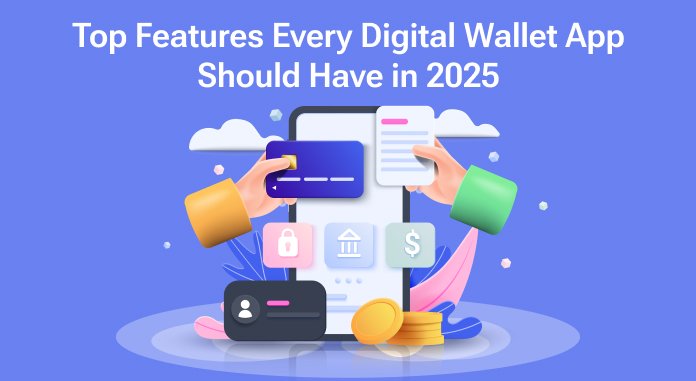The world of digital payments is rapidly evolving. With the rise of fintech, blockchain, AI, and consumer demand for seamless experiences, digital wallet apps have become much more than just a way to store and transfer money.
In 2025 and beyond, businesses looking to enter or dominate the digital wallet space must prioritize user-centric, secure, and scalable features that stand out in a competitive market.
Whether you’re planning to launch your own solution or estimating the cost to build a wallet like Payit, understanding the right feature set is critical. This blog will explore the top must-have features for digital wallet apps in 2025 and how they cater to both user expectations and business growth.
1. Biometric Authentication & Multi-Factor Security
Security is paramount in any digital wallet app. In 2025, biometric verification (fingerprint, facial recognition, or iris scan) combined with multi-factor authentication (MFA) is no longer a bonus—it’s a necessity.
Why it matters:
⦁ Reduces fraud and unauthorized access.
⦁ Enhances user trust by offering a high level of security.
⦁ Supports regulatory compliance like GDPR, PCI-DSS, and PSD2.
Pro tip: Use AI-powered anomaly detection and behavioral biometrics for added security intelligence.
2. Contactless Payments (NFC, QR & Bluetooth)
Users expect fast, frictionless payments. Integrating Near-Field Communication (NFC), QR code scanning, and even Bluetooth Low Energy (BLE) makes peer-to-peer (P2P) and in-store transactions simple and efficient.
Why it matters:
⦁ Meets the growing demand for hygienic, no-contact payments post-COVID.
⦁ Enables smooth experiences across different devices and platforms.
⦁ Boosts merchant adoption of your wallet app.
3. AI-Powered Smart Spending Insights
In 2025, users want more than transactions—they want intelligent financial tools. Integrate AI-driven insights that analyze spending patterns, categorize expenses, and provide personalized financial advice.
Key benefits:
⦁ Helps users budget more effectively.
⦁ Encourages saving habits and reduces churn.
⦁ Positions your app as a financial companion, not just a payment tool.
4. Multi-Currency and Cross-Border Payments
Globalization demands digital wallets that support multi-currency transactions and seamless cross-border payments.
Why it’s essential:
⦁ Enables international purchases and remittances.
⦁ Appeals to freelancers, digital nomads, and global businesses.
To achieve this, partnering with a trusted mobile app development company in Dubai can help integrate global payment gateways and currency exchange services, ensuring optimal conversion rates and lower transaction fees.
5. Virtual Cards & Tokenization
Virtual cards enable users to make safe online transactions without revealing their main card details. Combined with tokenization, this provides an added layer of transaction protection.
Key use cases:
⦁ Temporary cards for one-time use.
⦁ Masked card numbers for privacy.
⦁ Better fraud prevention and spending control.
6. Bill Splitting & Group Payments
In the digital-first world, sharing expenses for rent, dinners, or subscriptions is common. A built-in bill splitting feature enables users to split costs easily with friends, roommates, or colleagues.
Why users love it:
⦁ Eliminates awkward follow-ups.
⦁ Enhances the social aspect of payment apps.
⦁ Boosts retention, especially among Gen Z and millennial users.
7. Loyalty, Cashback & Rewards Integration
Users appreciate rewards. Your app should offer a built-in loyalty engine or integrate with third-party programs to provide cashback, vouchers, coupons, and rewards.
How it helps your app:
⦁ Increases transaction frequency.
⦁ Enhances customer engagement.
⦁ Promotes specific merchants or services within the app.
Gamified elements—like spin-the-wheel cashback or tiered rewards—can also drive user interest and fun.
8. Digital ID & KYC Integration
To meet compliance and improve user onboarding, digital wallet apps must include eKYC (electronic Know Your Customer) and Digital Identity Verification features.
Why it matters in 2025:
⦁ Streamlines onboarding and reduces dropout rates.
⦁ Ensures compliance with financial regulations.
⦁ Prevents fraudulent accounts.
Leverage AI and OCR (Optical Character Recognition) to auto-fill user information from documents and reduce friction.
9. Crypto Wallet Support
As cryptocurrencies continue to gain traction, modern digital wallets should offer crypto wallet integration to support storage, sending, receiving, and exchanging of crypto assets like Bitcoin, Ethereum, and stablecoins.
What to include:
⦁ Real-time price charts.
⦁ Secure private key storage.
⦁ Easy conversion between fiat and crypto.
Even if your app isn’t crypto-native, allowing users to track their crypto portfolio can provide value.
10. Chatbot & Voice Assistant Support
Integrating AI-powered chatbots or voice assistants like Alexa, Siri, or Google Assistant helps users navigate their app or resolve issues instantly.
Why it’s a must-have:
⦁ Reduces load on support teams.
⦁ Offers 24/7 assistance.
⦁ Supports users with accessibility needs.
⦁ Smart conversational UI also personalizes the app experience for users.
11. Personalized Dashboard & Transaction History
A dynamic and intuitive dashboard that shows balances, recent transactions, rewards, budgets, and financial insights in one place is critical.
Must-have features:
⦁ Filterable transaction history.
⦁ Downloadable statements.
⦁ Graphical spending summaries.
Give users control over what they see and how their data is displayed.
12. Subscription & Bill Management
People use digital wallets for recurring payments—subscriptions to Netflix, utility bills, gym memberships, and more. Integrating automated subscription tracking and bill reminders can position your app as an all-in-one finance tool.
Top functionalities:
⦁ Auto-debit setup.
⦁ Alerts before due dates.
⦁ Cancel or pause subscriptions in-app.
This reduces missed payments and enhances user satisfaction.
13. Seamless P2P Transfers
Peer-to-peer payments are the core of digital wallet app development. The transfer process should be instant, zero or low-cost, and require minimal effort—such as using mobile numbers, UPI IDs, or QR codes.
Advanced features:
⦁ Scheduled transfers.
⦁ Voice-activated sending.
⦁ Payment links or invoices.
Instant notifications and receipts are a must for transparency.
14. Offline Functionality
In many regions, especially emerging markets, users face poor internet connectivity. Offline transaction support using SMS-based verification, Bluetooth, or NFC fallback can help your wallet stay accessible anywhere.
Advantages:
⦁ Widens your app market.
⦁ Build trust in low-connectivity areas.
⦁ Offers an edge over data-dependent competitors.
Final Thoughts!
The eWallet market is projected to reach $16 trillion by 2028, and competition will only grow fiercer. To stay ahead, companies must prioritize features that deliver not only security and usability, but also intelligent insights, global capabilities, and rewarding user experiences.
Investing in the right features today can help you create a product that scales with evolving customer needs and regulatory demands in 2025 and beyond.









